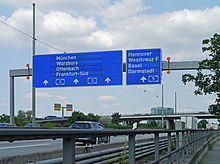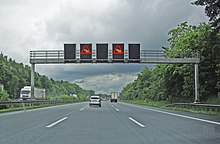Variable message signs
The variable message sign ( VMS for short ) is a special form of traffic sign that can be shown, changed or canceled if necessary. The display of dynamic traffic signs is used for traffic safety and traffic control on busy expressways and motorways . The display is controlled by a traffic control center . There you monitor the traffic situation at selected points and react to events such as an accident or traffic jam if necessary. In some cases, the control is also carried out automatically, for example in the event of poor visibility ( fog warning system ).
In addition to the dynamic display of traffic signs, signposts can also be used as so-called variable signposts .
technology
A general distinction is made between mechanical variable message signs (so-called “prism inverters”) and light-emitting variable message signs.
Mechanical variable message signs
With mechanical variable message signs, the image change is achieved by rotating individual or several coupled triangular or square prisms , which are moved by a motor via a worm or toothed belt drive. So three or four different image positions are possible for each prism drive. The prisms can be arranged horizontally and vertically and, like a static traffic sign, are covered with reflective foil. Such shift indicators can be integrated into pioneering signage, for example, alternative routes for traffic problems on the main line display (so-called variable routing ).
Due to the low power consumption (power only required during the image change), mechanical variable message signs can be implemented with photovoltaic energy supply.
Light-emitting variable message signs
In the case of light-emitting variable message signs, the signs are displayed by a large number of high-performance LEDs - in older variable message signs also by glass fiber optics with central halogen lamps. The LED and fiber optics are provided with an optical attachment that focuses the light emitted onto the road user. The strong luminosity ensures a good visibility of the variable message signs even with precipitation or fog.
WVZ with halogen lamps contain i. d. Usually two halogen lamps and a failure monitor, which switches on the second lamp and sends a fault message if one lamp fails. In the LED VMS, the light points of the various LED chains combined in chains are inserted alternately so that if individual LED chains fail, the VMS does not fail completely and no incorrect content can be displayed. Here, too, monitoring of the LED chains is state of the art. A failure of one or more LED chains is reported by the control to the higher-level control center.
The traffic signs shown can be changed by specifically turning the LEDs on or off. Depending on the spatial arrangement of the LEDs, only certain traffic signs or any symbols can be displayed (matrix display).
On luminous variable message signs, the colors black and white may be interchanged compared to the information in the traffic sign catalog.
commitment
Variable message signs are attached to various supporting structures either individually or in groups. They are either on a sign gantry that spans the roadway or on a mast to the side of the roadway. In addition to the display of traffic signs and associated information (variable message sign system), signposts and destination information (variable direction sign system) are also displayed.
Due to the prism technology, mechanical variable message signs can only display a small amount of different information and are therefore suitable for use in variable signpost systems, for example.
With the light-emitting variable message signs, significantly more different information can be displayed. They are usually used in route control systems that are installed on motorway and expressway sections with high traffic density, in front of and in road tunnels or at motorway junctions. Variable message signs help prevent accidents, avoid congestion or warn of other events. The mobile version of the systems is now also being used on motorway construction sites to indicate hazards if necessary and to adjust the speed limit.
VMS are also used on heavy haulage vehicles. These take precedence over the other stationary traffic signs and must be observed ( Section 39 (6) StVO).
The information shown for fixed VMS varies depending on the location. In Germany or Austria, for example, the usual traffic signs are usually used, supplemented with information. In other countries, such as Italy, entire sentences are often displayed with tips on how to drive safely, information about the length of traffic jams or waiting times at the border. Out of consideration for tourism, these sentences are often also presented in English.
In Austria, LED variable message signs with vehicle detection and control software are used as a warning system to reduce the risk at technically unsecured level crossings , as they increase awareness.
Norms and standards
- Germany
- Guidelines for variable message sign systems on federal trunk roads (RWVZ)
- Instructions for control models of variable message sign systems in extra-urban areas
- Austria
- RVS 04/05/21 Traffic control systems
- Switzerland
- SN 640 804 Traffic control on motorways and motorways; Change of direction
- SN 640 873-1 Vertical traffic signs - Variable message signs - Part 1: Product standard
- SN 640 873-2 Vertical traffic signs - Variable message signs - Part 2: Initial testing
- SN 640 873-3 Vertical traffic signs - Variable message signs - Part 3: Factory production control
Web links
Individual evidence
- ↑ PIARC Dictionary - term "variable message sign" ( Memento from April 2, 2016 in the Internet Archive )
- ^ Lukas Bauer: Handbook of traffic law . facultas.wuv / maudrich, 2009, ISBN 3-7089-0290-4 , p. 183 .
- ↑ Influencing traffic on German motorways and the effects on traffic safety, traffic flow and the environment ( Memento from October 18, 2011 in the Internet Archive )






